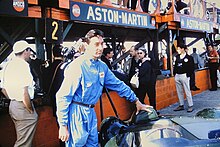Race
Day of the race would be sunny and warm, but the start of race was something of a shambles as some drivers posed for the tradition Le Mans style start, ready to sprint to their cars, while others were still ambling across the track. This prompted a false start, so everyone had to line-up again. [2] [3]
From his third place of the grid, Jim Jeffords was expected to be quick off the line, and indeed he was but a wheel problem stopped him out on the circuit, and by the end of lap one, he crossed the line in last place. [2]
The Aston Martins set the early pace with Moss going out in front. Hawthorn was second in his works Ferrari, with Salvadori in the other Aston on his tail. Soon, Salvadori moved past Hawthorn to make it an Aston 1-2. As for the Listers, they were going well in the opening laps, but Gendebien tried to force his Ferrari past Scott Brown, on the managed to climb right over the back of the Lister. Both drivers hopped out and removed the Ferrari and the Belgian took it back to the pits for repairs while the Lister retired. As for the other Lister, it only managed six laps before its Jaguar engine went and all the Jaguar-powered cars were out of the race by lap 55. [2] [5] [3]
As for the Hill/Collins Ferrari, it made a cautious start with the American behind the wheel. The crew decided to be easy on the gearbox and brakes which get worked so hard at Sebring. They were in fourth at the end of the first hour, with Moss/Brooks leading from Salvadori/Shelby and Hawthorn/von Trips. Their easy pace allowed the private 250 TR of Richie Ginther and Johnny von Neumann into fourth an hour later. The pair of Astons and the trio of Ferrari held the top five spots for the first four hours. The other works Ferrari of Musso/Gendebien started to recover from its early encounter. [6] [3]
It was all change in the fifth hour of the race when both Astons had gearbox troubles, which forces them to retire. Hill and Collins had progressively worked their way through to second and then took over the lead which they would not be moved. By the half-way mark, there were four Ferraris in the top four and that remained that way for the next five hours. Hawthorn and von Trips were out on lap 159, with Neumann and Ginther at lap 168. Hill and Collins still kept to a steady pace, the Musso/Gendebien car moved into second with the Porsche 718 RSK of Harry Schell and Wolfgang Seidel now up to third. Surprisingly, the little Lotus Eleven of Sam Weiss and David Tallakson had got into fourth overall. [7] [3] [8]
And that's how the race finished, the Scuderia Ferrari of Collins and Hill, winning ahead of their team-mates Musso and Gendebien. Car number 14, took an impressive victory, completing 200 laps, covering 1,040 miles after 12 hours of racing, averaging a speed of 86.501 mph. Second place went to the second Ferrari, albeit one lap adrift. The podium was complete by works Porsche of Schell and Seidel who were seven laps behind the winners. Phil Hill and Peter Collins had established the Ferrari 250 TR as the main sports car championship contender, with its second straight victory in the series. [9] [8]





